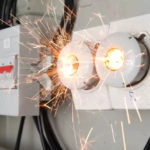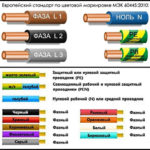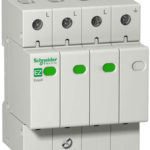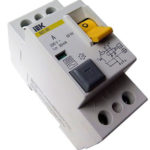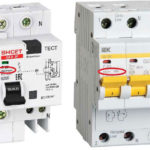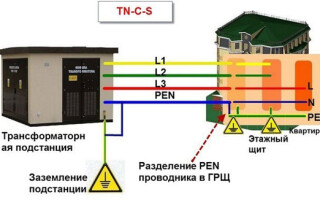Protective earth is a system designed to prevent the effects of electric current on a person by deliberately connecting to the ground the case and non-current-carrying parts of the equipment that may be energized. Grounding systems can be natural or artificial.
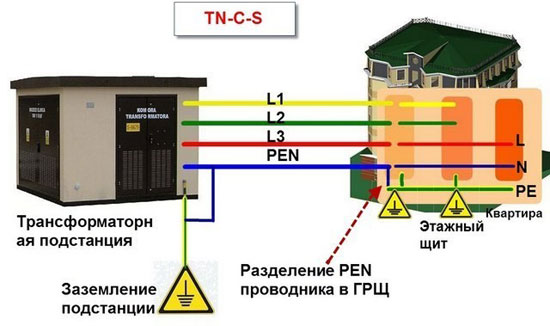
Content
What is grounding and why is it needed?
Grounding devices are a deliberate connection of electrical type conductors of various points of the electrical network.
The purpose of grounding is to prevent the effects of electric current on a person. Another purpose of protective grounding is to divert voltage from the body of the electrical installation through a grounding device to ground.
The main purpose of grounding is to reduce the potential level between the point that is grounded and the ground. This reduces the current strength to the lowest level and reduces the number of damaging factors in contact with parts of electrical appliances and installations in which a breakdown occurred on the case.
What is neutral?
neutral - this is a zero protective conductor that connects the neutrals of electrical installations in three-phase electric current networks. Scope of use - zeroing of electrical installations.
The step-down substation, where the transformer installation is located, is equipped with its own ground loop. This circuit consists of a steel tire and rods buried in the ground in a special way. A cable with 4 cores is laid to the consumption sources in the electrical panel from the substation. When the consumer of electricity needs power from a three-phase type circuit, then all 4 cores must be connected. When a different load is connected to the conductors, a neutral displacement occurs in the system, in order to prevent this displacement, a neutral conductor is used. It helps to symmetrically distribute the load on all phases.
What are PE and PEN conductors?
PEN conductor - this is a conductor that combines the functions of a zero protective and zero working conductor. It comes from the substation and is divided into PE and N conductors, directly at the consumer.
PE conductor - this is the protective grounding that we use, for example, in an apartment in a grounded outlet. PE-conductor is used for grounding devices, installations and devices where the voltage level does not exceed 1 kV.
This type of grounding is used for safety purposes only.This grounding ensures a continuous connection of all exposed and external parts. The mechanism ensures that the current drains to the ground, which appeared as a result of the ingress of electric current on the body of a device.
PEN-conductor (combination of zero protective and zero working conductor) is used when using a TN-C type grounding system.

Types of artificial grounding systems
In the classification of grounding systems, there are natural and artificial types of grounding.
Grounding systems of artificial type:
- TN-S;
- TN-C;
- TNC-S;
- TT;
- IT.
Types of grounding - decoding of the name:
- T - grounding;
- N - connection of the conductor to the neutral;
- I - isolation;
- C - combining the options of a functional and neutral wire of a protective type;
- S - separate use of wires.
Many people are interested in the question of what is called working grounding. In another way, it is called functional. The answer to this question is given by paragraph 1.7.30 of the PUE. This is the grounding of the points of the current-carrying parts of the electrical installation. It is used to ensure the functioning of electrical appliances or installations, and not for protective purposes.
Also, many are concerned about the question of what is protective grounding. This is the process of grounding devices to ensure electrical safety.
Systems with solidly earthed neutral of the TN earthing system
These systems include:
- TN-C;
- TN-S;
- TNC-S;
- TT.
According to clause 1.7.3 of the PUE, a TN system is a system in which the neutral of the power source is solidly grounded, and the open conductive parts of the electrical installation are connected to the solidly grounded neutral of the source by means of zero protective conductors.
TN includes elements such as:
- midpoint grounding, which is related to the power supply;
- external conductive parts of the device;
- conductor of neutral type;
- combined conductors.
The source neutral is solidly grounded, and the external conductors of the installation are connected to the solidly grounded midpoint of the source using protective type conductors.
It is possible to make a ground loop only in electrical installations, the power of which does not exceed 1 kV.
TN-C system
In this system, the zero protective and zero working conductors are combined into one PEN conductor. They are combined throughout the system. The full name is Terre-Neutre-Combine.
Among the advantages of TN-C, only easy installation of the system can be distinguished, which does not require much effort and money. Installation does not require improvement of already installed cable and overhead power lines, which have only 4 conductive devices.
Flaws:
- increases the likelihood of receiving an electric shock;
- line voltage may appear on the body of the electrical installation during an open circuit;
- high probability of loss of the grounding circuit in case of damage to the conductive device;
- such a system only protects against short circuits.
TN-S system
The peculiarity of the system is that electricity is supplied to consumers through 5 conductors in a three-phase network and through 3 conductors in a single-phase network.
In total, 5 conductive sources depart from the network, 3 of which perform the function of the power phase, and the remaining 2 are neutral conductors connected to the zero point.
Design:
- PN is a neutral mechanism that is involved in the circuit of electrical equipment.
- PE is a solidly grounded conductor that performs a protective function.
Advantages:
- ease of installation;
- low cost of purchase and maintenance of the system;
- high degree of electrical safety;
- no contour creation required;
- the ability to use the system as a current leakage protection device.
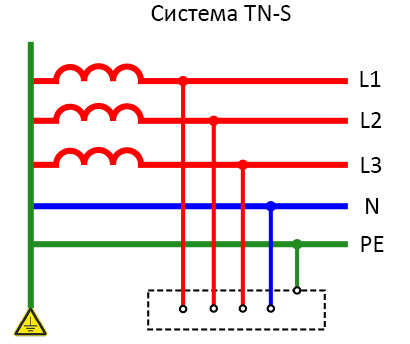
TN-C-S system
The TN-C-S system involves the division of the PEN conductor into PE and N in some section of the circuit. Usually the separation takes place in the shield in the house, and before that they are combined.
Advantages:
- a simple device of a protective mechanism against lightning;
- protection against short circuit.
Cons of using:
- low level of protection against combustion of the neutral conductor;
- the possibility of phase voltage;
- high cost of installation and maintenance;
- voltage cannot be switched off automatically;
- there is no outdoor current protection.
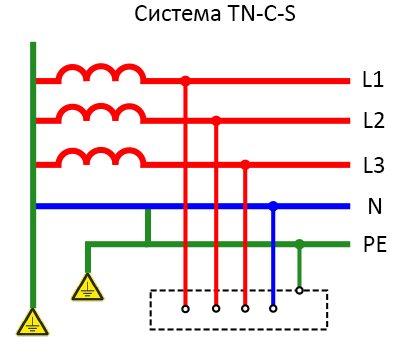
TT system
TT is designed to provide a high level of security. It is installed in power plants with a low level of technical condition, for example, where bare wires are used, electrical installations that are located outdoors or fixed on supports.
TT is mounted according to the scheme of four conductors:
- 3 phases supplying voltage are displaced at an angle of 120 ° between themselves;
- 1 common zero performs the combined functions of a working and protective conductor.
TT Benefits:
- high level of resistance to deformation of the wire leading to the consumer;
- short circuit protection;
- Can be used in high voltage electrical installations.
Flaws:
- sophisticated lightning protection device;
- impossibility to track the phases of the short circuit of the electrical circuit.
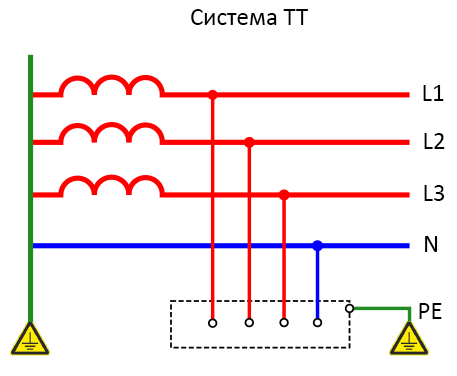
Systems with isolated neutral
During the transmission and distribution of electric current to consumers, a three-phase system is used. This makes it possible to ensure symmetry and uniform distribution of the current load.
Such a device creates a mode that involves the use of a transformer box and generators. Their neutral points are not equipped with an earth loop.
The isolated type of neutral is used in the power circuit when connecting the secondary windings of transformer installations according to the triangle circuit and in the absence of power during emergencies. Such a network is a replacement chain.
An insulated neutral contributes to the penetration of the insulating coating during a short circuit and the occurrence of a short circuit in other phases.
IT system
The IT system up to 1000 V provides grounding through a high resistance level and is equipped with a power supply neutral.
All external elements of the electrical installation, which are made of conductive materials, are grounded. Among the advantages, low current leakage rates during a single-phase short circuit of the electrical network can be distinguished. An installation with such a mechanism can function for a long time even in emergency situations. There is no difference between the potentials.
Disadvantage: current protection does not work in the event of a ground fault. During operation in the single-phase short circuit mode, the probability of electric shock increases when touching the second phase of the installation.
Similar articles:
